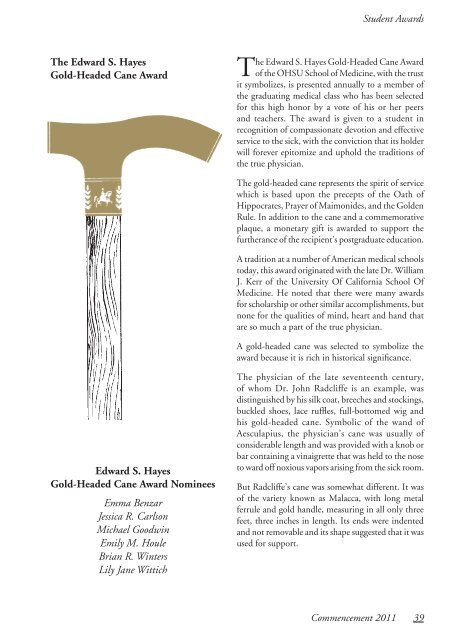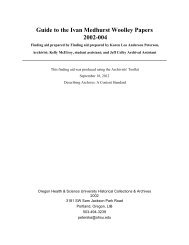Hooding and Commencement - Oregon Health & Science University
Hooding and Commencement - Oregon Health & Science University
Hooding and Commencement - Oregon Health & Science University
Create successful ePaper yourself
Turn your PDF publications into a flip-book with our unique Google optimized e-Paper software.
The Edward S. Hayes<br />
Gold-Headed Cane Award<br />
Edward S. Hayes<br />
Gold-Headed Cane Award Nominees<br />
Emma Benzar<br />
Jessica R. Carlson<br />
Michael Goodwin<br />
Emily M. Houle<br />
Brian R. Winters<br />
Lily Jane Wittich<br />
Student Awards<br />
The Edward S. Hayes Gold-Headed Cane Award<br />
of the OHSU School of Medicine, with the trust<br />
it symbolizes, is presented annually to a member of<br />
the graduating medical class who has been selected<br />
for this high honor by a vote of his or her peers<br />
<strong>and</strong> teachers. The award is given to a student in<br />
recognition of compassionate devotion <strong>and</strong> effective<br />
service to the sick, with the conviction that its holder<br />
will forever epitomize <strong>and</strong> uphold the traditions of<br />
the true physician.<br />
The gold-headed cane represents the spirit of service<br />
which is based upon the precepts of the Oath of<br />
Hippocrates, Prayer of Maimonides, <strong>and</strong> the Golden<br />
Rule. In addition to the cane <strong>and</strong> a commemorative<br />
plaque, a monetary gift is awarded to support the<br />
furtherance of the recipient’s postgraduate education.<br />
A tradition at a number of American medical schools<br />
today, this award originated with the late Dr. William<br />
J. Kerr of the <strong>University</strong> Of California School Of<br />
Medicine. He noted that there were many awards<br />
for scholarship or other similar accomplishments, but<br />
none for the qualities of mind, heart <strong>and</strong> h<strong>and</strong> that<br />
are so much a part of the true physician.<br />
A gold-headed cane was selected to symbolize the<br />
award because it is rich in historical significance.<br />
The physician of the late seventeenth century,<br />
of whom Dr. John Radcliffe is an example, was<br />
distinguished by his silk coat, breeches <strong>and</strong> stockings,<br />
buckled shoes, lace ruffles, full-bottomed wig <strong>and</strong><br />
his gold-headed cane. Symbolic of the w<strong>and</strong> of<br />
Aesculapius, the physician’s cane was usually of<br />
considerable length <strong>and</strong> was provided with a knob or<br />
bar containing a vinaigrette that was held to the nose<br />
to ward off noxious vapors arising from the sick room.<br />
But Radcliffe’s cane was somewhat different. It was<br />
of the variety known as Malacca, with long metal<br />
ferrule <strong>and</strong> gold h<strong>and</strong>le, measuring in all only three<br />
feet, three inches in length. Its ends were indented<br />
<strong>and</strong> not removable <strong>and</strong> its shape suggested that it was<br />
used for support.<br />
<strong>Commencement</strong> 2011 39
















